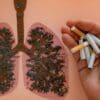Unmasking the Silent Threat: How Radon Gas Endangers Lung Health and Your Path to Wellness
Understanding Radon and Its Impact on Lung Health
Radon is a colorless, odorless, radioactive gas that originates from the natural decay of uranium present in soil and rocks. It’s a significant health hazard, particularly concerning lung health, as it is the second leading cause of lung cancer globally, following smoking.
When radon gas is released into the air, it can accumulate in homes, particularly in areas with poor ventilation. This gas seeps through cracks in floors and walls, construction joints, and gaps in foundations. The health risk arises when radon decay products, radioactive particles, become lodged in the lungs as people breathe in the contaminated air. Over prolonged exposure, these particles can damage lung tissues and lead to cancer.
The Mechanism of Damage
The primary danger of radon exposure comes from its radioactive particles, known as radon progeny. When inhaled, these particles can adhere to the lungs’ lining, emitting radiation that damages the DNA in lung cells. This radiation exposure can cause mutations that may lead to lung cancer. The risk is significantly higher for smokers because smoking and radon exposure have a synergistic effect, dramatically increasing the likelihood of cancer compared to either factor alone.
Global and Indian Context
Radon levels can vary widely depending on geographic and structural factors. In India, the Geological Survey of India has identified certain high-radon-prone areas, emphasizing the importance of radon testing and mitigation, especially in states with granitic terrains like Jharkhand, Chhattisgarh, and parts of Andhra Pradesh.
Testing and Mitigation
Testing for radon is crucial for determining radon levels in residential and occupational buildings. Simple and affordable test kits are available for home use. If high levels are detected, mitigation strategies such as improving ventilation, sealing floors and walls, and installing radon reduction systems can significantly reduce exposure.
Transitioning to a Healthier Lifestyle with Fitpaa
While understanding radon and mitigating its effects is crucial, embracing a healthier lifestyle is equally important for overall wellness. This is where Fitpaa can play a transformative role in your life. Fitpaa, with its comprehensive approach to health and fitness, not only helps you manage your metabolism but also supports your journey to better respiratory health.
Why Choose Fitpaa?
Fitpaa offers a personalized health capsule tailored to your needs, incorporating cutting-edge research in Lifestyle Medicine and Behavioral Therapy. By strengthening all organ systems, including the respiratory system, Fitpaa ensures you are better equipped to combat environmental health hazards like radon.
– Metabolism Assessment: Start with a thorough assessment of your current health status to understand and address any underlying issues.
– Personalized Fitpaa Capsule: Get a custom plan that includes medical exercise therapy, nutrition, and cognitive behavior therapy to optimize your metabolism and bolster your respiratory health.
– Daily Engagement: Through the Fitpaa app, you receive real-time guidance to maintain discipline and stay motivated, ensuring you follow through with your health plan.
Take Charge of Your Health
In a world with environmental hazards, taking proactive steps towards health and wellness is imperative. With Fitpaa, you have a dedicated partner committed to helping you achieve your health goals. Whether it’s building resilience against radon exposure or improving overall fitness, Fitpaa is your pathway to a healthier, happier life.
Download the Fitpaa app today and embark on a journey to not just understand the threats like radon but to overcome them with confidence, ensuring a life full of vitality for you and your loved ones.
This blog post provides a detailed exposition on radon’s impact on lung health and integrates Fitpaa’s offerings, encouraging readers to embrace a healthier lifestyle with the app.











